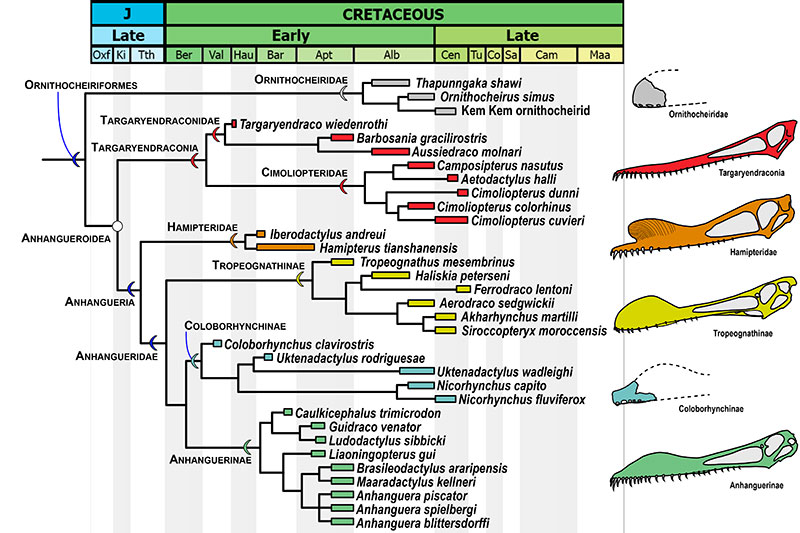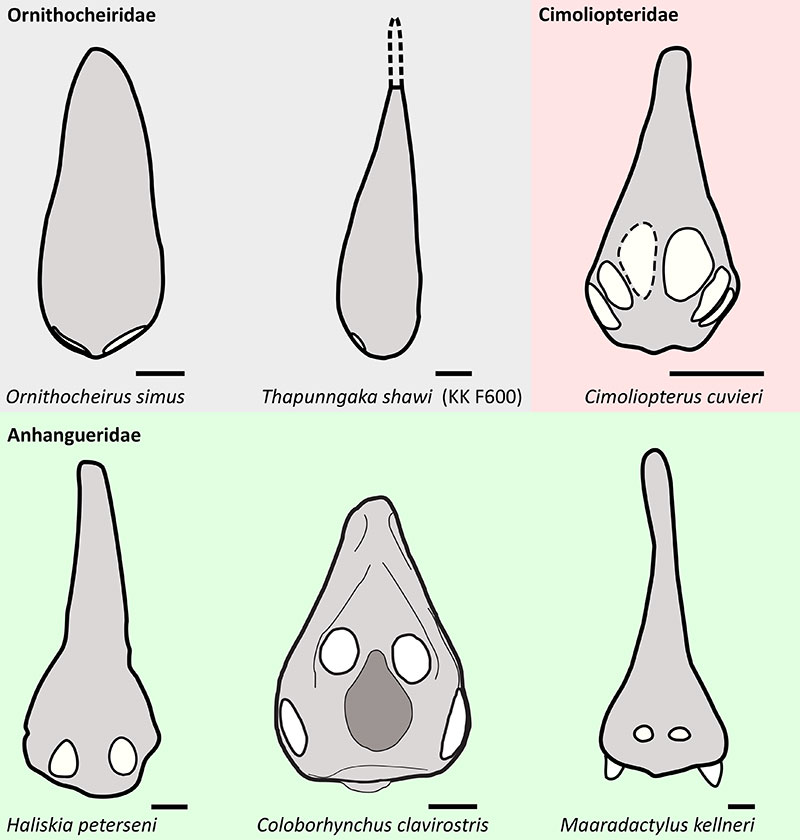FIGURE 1. Simplified representation of competing schemes of ornithocheiriform systematics and taxonomy. A, the “restrictive Anhangueridae” scheme, based on Kellner (2003), Rodrigues and Kellner (2013), and Wang et al. (2015). B, the “broad Ornithocheiridae” scheme, simplified from Unwin (1991, 2001, 2003), Bestwick et al. (2018), and Unwin and Deeming (2019). Note that under this scheme Anhangueridae is inapplicable, and Ornithocheiridae = Ornithocheiriformes in composition. C, the “restrictive Ornithocheirae” scheme (Andres, 2021). See text for further explanations about these schemes. Abbreviations: A.id., Anhangueridae; O.ae, Ornithocheirae; O.id., Ornithocheiridae.

FIGURE 2. Phylogenetic relationships and nomenclature of the Ornithocheiriformes according to the present work.

FIGURE 3. Rostrum tip in anterior view showing the absence or presence of a reflection of the palatal tip (with anteroventrally facing first premaxillary alveoli). Note that the first upper alveoli face lateroventrally in ornithocheirids (reflection of the palatal tip absent), whereas it faces anteroventrally in anhangueroids (reflection of the palatal tip present). Scale bars equal 10 mm.

FIGURE 4. Comparative scheme of the rostrum (in right lateral view) between main ornithocheiriform lineages. Note that the first upper alveolus is level with the second one in Ornithocheirus simus (reflection of the palatal tip absent), whereas it is dorsally raised in anhangueroids (reflection of the palatal tip present). Blue arrows indicate first alveolus. Note also the anteroventral inclination of the second alveolus, steeper in anhanguerids than in other ornithocheiriforms. Dashed lines indicate anteroventral inclinations of second and third alveoli. A, Ornithocheirus simus holotype (CAMSM B54428). B, Cimoliopterus cuvieri holotype (NHMUK PV 39409), mirrored. C, Hamipterus tianshanensis (MN 7538-V, cast). D, Tropeognathus mesembrinus holotype (BSPG 1987 I 46). E, Uktenadactylus wadleighi holotype (SMU 73058; modified from Holgado and Pêgas, 2020). F, Anhanguera sp. (SMNK PAL 2302). G-L, respective schematic drawings. Scale bars equal 20 mm.

FIGURE 5. Comparative scheme of the rostrum (in occlusal view) between main ornithocheiriform lineages. Note that, while targaryendraconians such as Cimoliopterus exhibit a laterally expanded third alveolus (as indicated by the blue lines), an anhanguerian-like expansion of the premaxilla itself is lacking (as indicated by the red lines). Anhanguerians also exhibit a laterally expanded third alveolus (but blue lines indicating this in anhanguerians are not included for simplicity), while ornithocheirids do not. A, Ornithocheirus simus holotype (CAMSM B54428). B, Cimoliopterus cuvieri holotype (NHMUK PV 39409). C, Hamipterus tianshanensis (MN 7538-V, cast). D, Tropeognathus mesembrinus holotype (BSPG 1987 I 46). E, Uktenadactylus wadleighi holotype (SMU 73058; modified from Holgado and Pêgas, 2020). F, Anhanguera sp. (SMNK PAL 2302). G-L, respective schematic drawings. Scale bars equal 20 mm.


